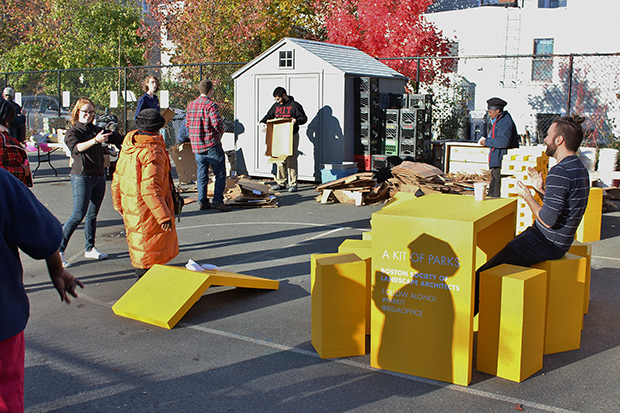Prakkamakul与BCNC协力完成中国城艺术装置
The installation activates an empty lot near the Chinatown Gate with a series of interactive art pieces
 Sasaki
Sasaki

If you can think it, you can make it. The internet age has long emphasized a do-it-yourself attitude, which has found firm footing with the rise of Think/Make culture. 3D modeling software and rapid prototyping machinery are making it easier than ever to translate design ideas into tangible reality—in materials as varied as plastic, metal, and concrete. As these technologies continue to improve and advance, the level of complexity achievable expands—a fact that has many industries reevaluating the limits of what is possible. For architects and engineers, in-house fabrication and prototyping done with 3D printers and CNC routers allow for experimenting with scale models, facades and curtail walls, furniture and fixtures, building system details, landscape forms—the list can go on. Truly, if you can think it, you can make it.
For landscape architects, Think/Make culture also offers the ability to intervene in urban environments like never before, enabling them to iterate placemaking innovations. It traditionally takes years or decades for most landscape architects to see their vision for a space fully realized. DIY placemaking and the Tactical Urbanism movement provide opportunities for designers to disrupt that longer process to create human-centric spaces in a much shorter timeframe. “Pop-up prototyping is liberating, offering designers freedom for experimentation and allowing communities to test ideas before making permanent public-space investments,” says Sasaki associate Nina Chase. #TacticalUrbanism, an increasingly popular hashtag on social media, challenges typical norms of what constitutes “place,” and turns the urban environment into a platform for experimentation and engagement.
True to the Think/Make spirit, the Boston Society of Landscape Architects (BSLA) teamed up with Sasaki designers Nina Chase, ASLA, and Philip Dugdale, International ASLA, earlier this year to create a “pop-up kit of parts to build a park” utilizing Sasaki’s Fabrication Lab (FabLab). Dubbed Kit of Parks, the final product embraces the popular parklet model, but adds a twist: the kit is packable, lightweight, and mobile.

Created out of affordable materials, and constructed on a CNC router, Kit of Parks is designed to be portable, serving under-programmed public spaces in any neighborhood. While parklets and pop up parks have cropped up across the country and have become popular within the design community, Kit of Parks’ mobility enables accessibility to a much broader audience. “Kit of Parks can be biked anywhere and unpacked in less than 10 minutes. It provides an instant boost of color, fun, and community gathering wherever it is parked,”explains Philip Dugdale.
The first Kit of Parks was designed and constructed for the BSLA’s expo booth at Boston’s ABX 2015, and contains a high top table, benches, side tables, stools, planters, jenga, bean bag toss—all easily contained within a 4’x8′, 125 lb carrier that hitches to a bicycle trailer for easy transport. The kit has also seen practical use at a Cambridge, MA turkey drive at the Margaret Fuller Neighborhood House and at New England Grows. The Kit of Parks design team envisions a series of Kits that can be adapted to activate public spaces with pop-up cafes, reading areas, happy hour hangouts, children’s playspaces, and more.
Kit of Parks exemplifies what can be accomplished when savvy design and ease of fabrication come together—creating new opportunities for how to define space and create meaningful places.
For more on the subject, check out this recent article on the evolution of public art, follow the #TacticalUrbanism hashtag on Twitter, and check out the video below.
